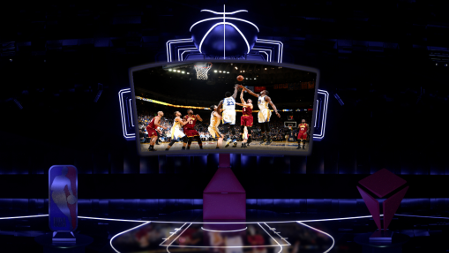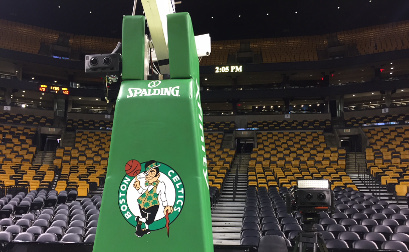NBA’s VR Plans for 2017 Show Technology Maturation
BALTIMORE—The first thing Josh Earl says when asked about the evolution of the NBA League Pass Virtual Reality (VR) schedule is that most of the people working on the broadcasts come “from the traditional 2-D world.”

New this season is the“NextVR Screening Room” which allows NBA League Pass subscribers to get their headsets on and watch any NBA League Pass game on a virtual movie theater-sized screen.
Given that case, the progress made by Earl, head of sports production, and his colleagues at Newport Beach, Calif.-based Next VR—NBA League Pass’s official partner on the broadcasts—is impressive.
“Last season, we were just trying to get basics down, like cross roll video, skipping replays and trying to figure out how to adjust when play was stopped, because we don’t have commercial breaks” said Earl, noting that the revenue for this season’s schedule of 27 live games to be broadcast in VR is generated via NBA League Pass subscriptions, which are also available on Google Daydream, Samsurg Gear VR, Microsoft Windows and PlayStation VR.
SETTING UP
New this season is the “NextVR Screening Room,” which allows NBA League Pass subscribers to get their headsets on and watch any NBA League Pass game on a virtual movie theater-sized screen. It allows fans to immerse themselves in a 360-degree VR environment, with the opportunity to select up to 13 NBA games to livestream on a massive virtual screen; in addition, International NBA League Pass subscribers will have access to every NBA game during the 2017-18 season, in addition to the 27 immersive VR productions.
What happened after Next VR’s first season is that the basic broadcast has evolved to what Earl described as “full dynamic traffic, with great graphics that were enhanced during the year and on some occasions, even during the game.” He pointed to new product features, like live volumetric telestration, live infographics and dynamic stats, as among the reasons for the leagues progress in VR.
The professional video industry's #1 source for news, trends and product and tech information. Sign up below.
“This isn’t just about what we [prepare] before the broadcast, but to tell the story of the game on the fly”―such as when on-air talent uses telestration in the 3-D experience by drawing right on the court.
Since launching VR coverage of its games last season, the telecasts have grown to encompass heightened specifications. “We are lens-to-lens, taking the action from the court to within the VR headset, with our cameras custom-built, in-house,” said Earl. While how that’s accomplished is mostly proprietary, he acknowledged that the company is already using third-generation cameras that have gotten “much smaller.
“They’re about half the size of the cameras we used last year,” he said. Next VR is using approximately nine cameras during each game this season: behind and above each basket, two at the scorer’s table, one up high in the first level of seats, and in the tunnels to the dressing rooms. There is also a talent camera that breaks down during the action.
“We’re somewhat at the mercy of the arenas, as far as set-up goes,” said Earl, adding that Next VR has to work around the several regular cameras that are employed during any NBA broadcast.
NEW ANGLES
The progress is also obvious from what’s going on outside the arena. “We now have two of our own custom-built trucks,” Earl said. “Everything we have is custom built.”
So far, “all of it is going well” with the partnership with the NBA, he said. “The new camera angles are big, a game changer. People are loving the shot from behind the glass and the telestration. But, first and foremost, viewers are noting the evolution of the production, perhaps most obviously the new camera that’s mounted behind the backboard (behind the box, above the rim).

Next VR is using approximately nine cameras during each game this season.
Jeff Marsilio, vice president, global media distribution for the NBA, said that the league has been “extremely pleased with the progress we’ve made delivering games in virtual reality to our fans. By committing to a schedule throughout the season, we were able to execute, solicit feedback and implement enhancements on a weekly basis.
“The fan response to date has been very positive,” Marsilio added, “and we look forward to making similar leaps in year two as the technology advances and we gain more experience.”
ON THE HORIZON
The games are only part of what is offered in this VR domain. “Full game replays and highlight packages are complimentary after downloading the free apps,” said Lisa Beachy, director of public relations for Next VR, who added that the company is also involved in ventures with the NFL, Live Nation, NBC’s World of Dance and others.
With every game, Earl and company are envisioning what other accents Next VR can add to the broadcasts. “As we push forward, we’re looking to add more and unique angles to give viewers an experience they can’t get anywhere else,” he said. “That’s part of what makes our job fun. There are frustrations when something doesn’t work as planned but, all told, it’s great getting an opportunity to build something from the ground up.”
Editor's Note:
On Nov. 7, Turner Sports and Intel announced a multiyear partnership that will provide live NBA game action in virtual reality by using the Intel True VR technology. Intel will serve as the exclusive provider of virtual reality for the NBA on TNT and begin broadcasting games starting with the NBA All-Star Game in February. Using Intel freeD technology, Intel can also integrate 360-degree volumetric video into the VR experience.
Every virtual reality game experience will be available through the upcoming NBA on TNT VR app on Samsung GearVR and Google Daydream headsets.
Mark R. Smith has covered the media industry for a variety of industry publications, with his articles for TV Technology often focusing on sports. He’s written numerous stories about all of the major U.S. sports leagues.
Based in the Baltimore-Washington area, the byline of Smith, who has also served as the long-time editor-in-chief for The Business Monthly, Columbia, Md., initially appeared in TV Technology and in another Futurenet publication, Mix, in the late ’90s. His work has also appeared in numerous other publications.

